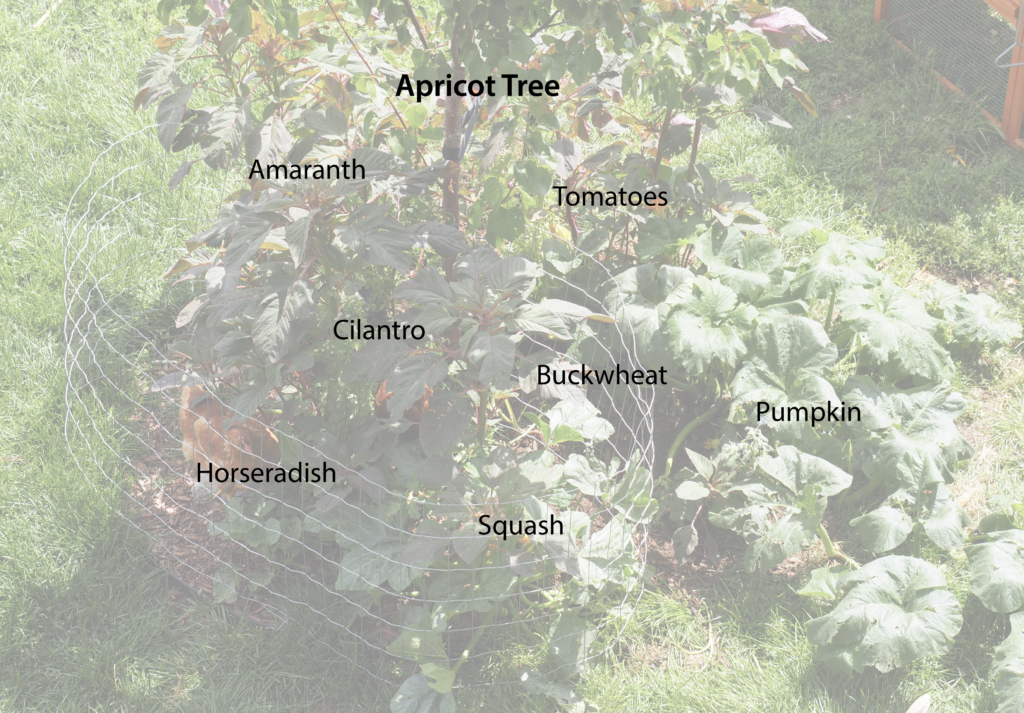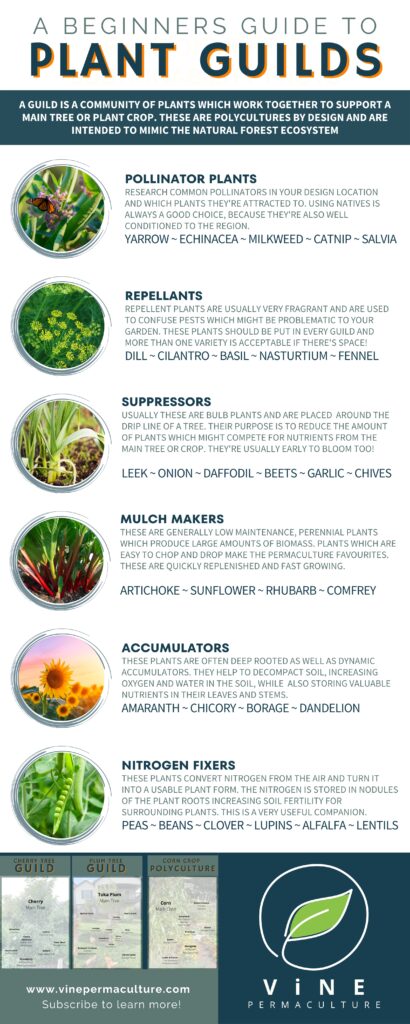Nitrogen fixing plants take atmospheric nitrogen from the air and make it available in the soil for other plants to take up. The nitrogen is stored in nodules of the plant roots increasing soil fertility for surrounding plants. Nitrogen fixing plants play a vital role in a permaculture garden. Make sure you include them in your plant guilds when designing a permaculture garden. This blog looks at why you should include nitrogen fixing plants in your garden.
What is Nitrogen and Why Do Plants Need It?
Nitrogen is an essential element for plant growth and is a crucial component of various biomolecules that play a fundamental role in a plant’s life cycle. It is a major building block for proteins, enzymes, nucleic acids (DNA and RNA), and chlorophyll, the green pigment responsible for photosynthesis. However, despite nitrogen being the most abundant gas in the Earth’s atmosphere (about 78% of the air is nitrogen gas), most plants cannot directly utilize atmospheric nitrogen in its gaseous form.
The Nitrogen Cycle:
Before we delve into the reasons for using biomass from nitrogen-fixing plants, let’s briefly understand the nitrogen cycle. The nitrogen cycle is a natural process that involves the conversion of nitrogen between different forms in the environment, enabling its availability to living organisms. The cycle consists of several interconnected steps, including nitrogen fixation, ammonification, nitrification, and denitrification.
Nitrogen Fixation:
Nitrogen fixation is a critical process in which certain microorganisms, like bacteria and some cyanobacteria, have the unique ability to convert atmospheric nitrogen gas into ammonium, a form of nitrogen that plants can absorb and utilize. This process occurs either through a symbiotic relationship between these nitrogen-fixing bacteria and specific plants (legumes like beans, peas, and clover) or through free-living nitrogen-fixing bacteria in the soil.
Why Use Biomass from Nitrogen-Fixing Plants?
Using biomass from nitrogen-fixing plants makes sense for several reasons. Firstly, these plants have a remarkable ability to enrich the soil with nitrogen. When they grow, they form root nodules that house nitrogen-fixing bacteria. These bacteria take nitrogen from the air and convert it into ammonium, which gets released into the soil as a nitrogen source. This natural process helps to replenish the soil with nitrogen, enhancing its fertility without the need for synthetic nitrogen fertilizers.
Nitrogen Fertilizer and Plant Growth:
While nitrogen is crucial for plant growth, synthetic nitrogen fertilizers are commonly used in agriculture to supply crops with readily available nitrogen. These fertilizers boost plant growth, increase crop yields, and contribute to food production for a growing global population. However, their excessive use can have negative consequences for the environment.
What Happens If There Is Too Much Nitrogen?
When excess nitrogen from synthetic fertilizers is applied to the soil or enters water bodies, it can lead to environmental issues. Some of the problems associated with nitrogen overload include:
Eutrophication: Nitrogen runoff into water bodies causes excessive algae and aquatic plant growth, leading to oxygen depletion and harm to other aquatic life forms.
Groundwater Contamination: Nitrate, a form of nitrogen, can leach into groundwater, making it unsafe for human consumption.
Air Pollution: Ammonia emissions from excessive fertilizer use can contribute to air pollution and even form fine particulate matter, affecting human health and the environment.
Nitrogen Deficiency in Soil: Surprisingly, excessive nitrogen can create imbalances in the soil by inhibiting the growth of beneficial microorganisms that help plants absorb other essential nutrients.
Majority of Nitrogen on Earth:
Despite atmospheric nitrogen being abundant, the majority of nitrogen on Earth is found in the form of inaccessible nitrogen gas in the atmosphere. The nitrogen in the atmosphere is inert and cannot be used directly by most plants and animals. The nitrogen that is readily available for plant uptake is found in the soil in the form of nitrates and ammonium, which are products of the nitrogen cycle.
Nitrogen is a crucial element for plant growth, and its availability in the soil determines the productivity of plants. Utilizing biomass from nitrogen-fixing plants helps enrich the soil naturally by increasing its nitrogen content, reducing the dependence on synthetic nitrogen fertilizers, and contributing to more sustainable agricultural practices.
However, it is essential to manage nitrogen fertilizers responsibly to avoid environmental issues associated with nitrogen overload, such as eutrophication, groundwater contamination, and air pollution. Understanding the nitrogen cycle and its role in supporting plant growth is vital in making informed decisions to protect our ecosystems while maximizing agricultural productivity.

Why Incorporate Nitrogen Fixing Plants in Your Garden
Incorporating nitrogen-fixing plants, especially leguminous crops, into your garden can be a smart and eco-friendly choice. These plants have a unique ability to form a symbiotic relationship with nitrogen-fixing bacteria, allowing them to convert atmospheric nitrogen into a usable form that enriches the soil. Let’s explore the benefits of including nitrogen-fixing plants in your garden and some common practices like using cover crops and green manure.
1. Value and Amounts of Nitrogen Fixation in Leguminous Crops:
Leguminous crops, such as peas, beans, lentils, and clover, are excellent choices for nitrogen fixation. These plants host special structures called root nodules, which house nitrogen-fixing bacteria, typically of the Rhizobia genus. Through this symbiotic relationship, the bacteria take nitrogen gas from the air and convert it into ammonium, a form of nitrogen that plants can easily absorb and utilize.
The amount of nitrogen fixed by leguminous crops can vary depending on factors like plant species, soil conditions, and environmental factors. However, on average, leguminous crops can fix around 50 to 250 pounds of nitrogen per acre (or about 56 to 280 kilograms per hectare) during their growth cycle. This significant nitrogen contribution can greatly enhance soil fertility and benefit other non-leguminous plants grown subsequently.
2. Improved Soil Fertility:
One of the primary reasons to incorporate nitrogen-fixing plants in your garden is to improve soil fertility. By growing leguminous cover crops or intercropping them with other crops, you can naturally increase the nitrogen content in the soil. This reduces the reliance on synthetic nitrogen fertilizers, which can have harmful environmental impacts when overused.
3. Cover Crop Benefits:
Using nitrogen-fixing plants as cover crops is a common practice among gardeners and farmers. Cover crops are grown primarily to benefit the soil rather than for harvesting. When you plant leguminous cover crops during fall or winter, they protect the soil from erosion, suppress weeds, and improve soil structure by adding organic matter when they are later turned into the soil as green manure.
4. Green Manure:
Green manure refers to the practice of incorporating freshly cut, green plant material into the soil to improve its nutrient content. Leguminous crops, after reaching a certain growth stage, can be cut and tilled directly into the soil as green manure. As the plant material decomposes, it releases nitrogen and other essential nutrients, enhancing soil fertility for future plantings.
5. Enhancing Crop Rotation:
Integrating nitrogen-fixing plants into your garden’s crop rotation plan is an effective way to maintain soil health and break pest and disease cycles. By rotating leguminous crops with other vegetables or fruits, you can optimize nutrient availability, reduce the risk of soil-borne diseases, and promote a sustainable gardening system.
6. Sustainable Gardening Practices:
Incorporating nitrogen-fixing plants aligns with sustainable gardening practices. It promotes natural nutrient cycling, reduces the need for synthetic fertilizers, conserves water (as healthy soil retains moisture better), and fosters biodiversity by attracting beneficial insects and supporting microorganisms in the soil.
Advantages of Fixing Nitrogen with Cover Crops
Cover crops offer numerous advantages when it comes to fixing nitrogen in the soil, benefiting both the garden and the environment. Let’s explore the benefits of using cover crops for nitrogen fixation, the best cover crops for this purpose, and the potential implications of excessive nitrogen. We’ll also discuss which crops tend to deplete nitrogen levels in the soil and the typical nitrogen content found in cover crops.
1. Best Cover Crop to Fix Nitrogen:
Several cover crops excel at fixing nitrogen in the soil due to their symbiotic relationship with nitrogen-fixing bacteria. Leguminous cover crops, such as hairy vetch (Vicia villosa), crimson clover (Trifolium incarnatum), and winter peas (Pisum sativum), are among the best choices. These cover crops form root nodules that host nitrogen-fixing bacteria, allowing them to convert atmospheric nitrogen into forms usable by plants.
2. Improving Soil Fertility:
The primary advantage of using cover crops for nitrogen fixation is their ability to improve soil fertility. As the leguminous cover crops grow, they actively take nitrogen from the air and store it in their plant tissues. When the cover crops are terminated or turned into the soil as green manure, the nitrogen-enriched plant material decomposes, releasing valuable nutrients into the soil. This process increases the overall nitrogen content, benefiting subsequent crops that follow in the rotation.
3. Mitigating Nitrogen Deficiency:
By fixing nitrogen in the soil, cover crops help prevent nitrogen deficiency in other plants. Nitrogen is a crucial element for various physiological processes in plants, including leaf and stem growth, flower development, and fruit production. When nitrogen levels are insufficient, plants may exhibit stunted growth, yellowing leaves, and reduced yields. Utilizing cover crops to fix nitrogen helps ensure that subsequent crops have an adequate and consistent supply of this essential nutrient.
4. Reducing Nitrogen Leaching:
Cover crops play a vital role in reducing nitrogen leaching. When nitrogen is in excess or not taken up by plants, it can be vulnerable to leaching, where it moves down through the soil and may reach groundwater or nearby water bodies. This can lead to environmental issues like water pollution and eutrophication. Cover crops take up excess nitrogen, minimizing the risk of leaching and helping to keep nitrogen cycles in balance.
5. Crops That Remove Nitrogen from the Soil:
Some crops are particularly efficient at removing nitrogen from the soil. Nitrogen-demanding crops like corn, cabbage, and tomatoes have high nitrogen uptake rates. Planting these crops in succession without proper nitrogen management or using cover crops for nitrogen fixation can deplete nitrogen levels in the soil, potentially leading to reduced yields and nutrient imbalances.
6. Nitrogen Content in Cover Crops:
The nitrogen content in cover crops can vary depending on the species, growth stage, and environmental conditions. On average, leguminous cover crops can contain between 1% to 4% nitrogen by dry weight. For instance, crimson clover may have nitrogen levels around 2.5% to 3.5%, while hairy vetch can range from 2% to 3%. These levels indicate the potential nitrogen contribution these cover crops can make when incorporated into the soil as green manure or as part of a crop rotation plan.
Using cover crops for nitrogen fixation offers numerous advantages for gardeners and the environment alike. Leguminous cover crops, such as hairy vetch, crimson clover, and winter peas, excel at fixing nitrogen due to their symbiotic relationship with nitrogen-fixing bacteria. By incorporating these cover crops into your gardening practices, you can enhance soil fertility, mitigate nitrogen deficiency, reduce nitrogen leaching, and create a more sustainable and balanced nutrient cycling system. Properly managed cover crops play a crucial role in maintaining soil health and optimizing crop yields while minimizing the environmental impacts associated with excessive nitrogen use.

Why is Nitrogen Fixing Important?
Nitrogen fixing is a crucial process with profound significance for life on Earth. It plays a central role in the nitrogen cycle, ensuring the availability of nitrogen in a usable form for various organisms, from plants to animals and microorganisms. Let’s explore why this process is essential to life, the relationship between nitrogen fixation and phosphorus, and which organisms lack the ability to fix nitrogen.
1. Importance to Life:
Nitrogen is an essential element for all living organisms because it is a fundamental component of biomolecules that are vital for life processes. Nitrogen is a key building block for proteins, enzymes, DNA, RNA, and chlorophyll, the green pigment crucial for photosynthesis. However, most living organisms cannot use atmospheric nitrogen directly, as nitrogen gas (N2) is relatively inert and stable. Nitrogen fixation is the process that converts atmospheric nitrogen into a form that plants and other living organisms can utilize.
2. Nitrogen Cycle and Ecosystem Balance:
The nitrogen cycle is a complex series of processes that involves the conversion of nitrogen between different forms, such as nitrogen gas (N2), ammonia (NH3), ammonium (NH4+), nitrite (NO2-), and nitrate (NO3-). Nitrogen fixation is a key step in this cycle, where certain microorganisms, particularly nitrogen-fixing bacteria, convert nitrogen gas from the atmosphere into ammonia or ammonium.
Ammonia and ammonium produced through nitrogen fixation become available in the soil and water, providing essential nitrogen sources for plant growth. Plants take up these forms of nitrogen and utilize them to produce proteins and other essential molecules. Animals then obtain nitrogen by consuming plants or other animals in the food chain. When organisms die or produce waste, nitrogen is returned to the soil, and the nitrogen cycle continues.
3. Phosphorus and Nitrogen Fixation:
The availability of phosphorus in the soil can influence the rate of nitrogen fixation. Phosphorus is another essential nutrient for plant growth, and it is involved in various cellular processes, including energy transfer and DNA synthesis. Adequate phosphorus levels can enhance the activity of nitrogen-fixing bacteria, leading to faster and more efficient nitrogen fixation. Phosphorus plays a role in promoting the formation of root nodules in leguminous plants, which host nitrogen-fixing bacteria, thereby supporting the symbiotic relationship and nitrogen fixation process.
4. Organisms Lacking the Ability to Fix Nitrogen:
Not all living organisms have the ability to fix nitrogen. While some bacteria, such as Rhizobia, Azotobacter, and cyanobacteria, are capable of nitrogen fixation, many other organisms lack this capability. For example: Animals, including humans, cannot fix nitrogen directly. They depend on nitrogen-rich plants or other animals in their diet to obtain the necessary nitrogen for their cellular processes.
Most plants, except for certain species like legumes (e.g., beans, peas, clover), cannot fix nitrogen on their own. Instead, they rely on nitrogen sources in the soil, either from nitrogen-fixing plants or synthetic fertilizers.
Fungi, while essential for nutrient recycling in ecosystems, generally do not fix nitrogen. Instead, they obtain nitrogen by breaking down organic matter or forming symbiotic relationships with nitrogen-fixing bacteria in the soil.
Nitrogen fixing is a vital process essential for life on Earth. It enables the conversion of atmospheric nitrogen into usable forms that support plant growth, the food chain, and the balance of ecosystems. Through nitrogen fixation, plants obtain the necessary nitrogen to produce essential biomolecules, which, in turn, sustain animals and other organisms in the ecosystem. The process ensures the continuous cycling of nitrogen through the environment, promoting a healthy and balanced ecosystem where life can thrive. Moreover, the relationship between nitrogen fixation and phosphorus availability highlights the interconnectedness of nutrients in the soil and their impact on ecosystem dynamics.

Some Examples
Nitrogen-fixing plants and bacteria play a vital role in enriching the soil with nitrogen, promoting plant growth, and supporting sustainable agricultural practices.
Examples of Nitrogen-Fixing Plants:
a. Clover (Trifolium spp.): Clover is a popular nitrogen-fixing plant commonly used as a cover crop in gardens and agricultural fields. It is easy to grow, establishes quickly, and its dense root system helps improve soil structure and prevents erosion.
b. Fava Beans (Vicia faba): Fava beans, also known as broad beans, are excellent nitrogen-fixing plants. They are cold-hardy and can be grown as cover crops or as a food crop. As they grow, fava beans enrich the soil with nitrogen through their symbiotic relationship with Rhizobia.
c. Alder Trees (Alnus spp.): Alder trees are nitrogen-fixing trees commonly found in wetland and riparian areas. They play a vital role in improving soil fertility in these ecosystems and can also be planted in gardens to enhance soil nitrogen content.
Learn More About Companion Planting with Nitrogen Fixing
Companion planting is a gardening technique that gains even greater significance when nitrogen-fixing plants are involved. This approach involves strategically pairing plants, with a particular focus on nitrogen fixers, to create beneficial interactions and enhance the health and productivity of your garden. Let’s delve into what companion planting is, how it benefits your garden through nitrogen fixation, the underlying philosophy, and the ultimate end goal of this environmentally friendly gardening practice.
1. What is Companion Planting and How Does Nitrogen Fixing Benefit Your Garden?
Companion planting revolves around the idea of planting compatible species together to encourage mutual support. Nitrogen-fixing plants, like leguminous crops, play a crucial role in this approach. Here’s how it benefits your garden:
a. Natural Nitrogen Enrichment: Nitrogen-fixing plants have a unique ability to convert atmospheric nitrogen into a usable form (ammonium) through a symbiotic relationship with nitrogen-fixing bacteria. When interplanted with nitrogen-demanding crops, these nitrogen fixers enrich the soil with readily available nitrogen. For instance, planting beans or clover alongside nitrogen-hungry tomatoes can boost the nitrogen content in the soil and support healthy tomato growth.
b. Sustainable Fertilization: By incorporating nitrogen-fixing plants as companions, gardeners can reduce the need for synthetic nitrogen fertilizers, which can leach into water bodies and harm the environment. This sustainable approach helps maintain soil fertility naturally and supports eco-friendly gardening practices.
c. Improved Soil Structure: As nitrogen-fixing plants grow and eventually decompose, they contribute organic matter to the soil. This process enhances soil structure, water retention, and aeration, benefiting the entire garden ecosystem.
2. The Philosophy of Companion Planting with Nitrogen Fixing:
The philosophy behind companion planting with nitrogen fixers is deeply rooted in ecological principles and traditional agricultural wisdom. Gardeners recognize the significance of nitrogen in plant growth and aim to mimic natural ecosystems where diverse plant species coexist and interact beneficially.
The emphasis lies in harnessing the power of nitrogen-fixing plants to create a balanced, self-sustaining garden. Instead of relying solely on external inputs like synthetic fertilizers, companion planting promotes a more integrated, holistic approach, leveraging the capabilities of nitrogen fixers to foster a healthier, harmonious garden ecosystem.
3. The End Goal of Companion Planting with Nitrogen Fixing:
The ultimate end goal of companion planting with nitrogen fixers is to establish a resilient, nutrient-rich garden that thrives without excessive human intervention. By strategically planting nitrogen-fixing species alongside other crops, gardeners ensure a continuous supply of nitrogen to support plant growth and development.
Incorporating nitrogen-fixing cover crops like clover, hairy vetch, or fava beans in rotation with vegetable crops aids in maintaining soil fertility. The garden ecosystem becomes more balanced, with a reduced risk of nitrogen deficiency for other plants. Additionally, companion planting with nitrogen fixers contributes to better pest management, as healthier plants are more resistant to pests and diseases.

Companion planting with a focus on nitrogen-fixing plants is an effective and sustainable gardening approach. By thoughtfully pairing nitrogen fixers with other crops, gardeners can tap into the benefits of natural nitrogen enrichment, reduce reliance on synthetic fertilizers, and foster a more resilient and biodiverse garden ecosystem. Embracing this philosophy of working with nature and integrating nitrogen fixers into your gardening practices not only promotes a thriving and fruitful garden but also supports a healthier environment and more sustainable agricultural practices.

About The Writer
Cormac is located in Derry, Northern Ireland and he is the founder of Vine Permaculture. He has 10 years of experience in permaculture gardening and has worked on over 20 permaculture designs and counting. He lives on a small urban plot and has experience raising chickens, worm farming, composting and growing in an urban environment. He is currently studying for a Diploma in Permaculture Design with the UK Permaculture Association.






